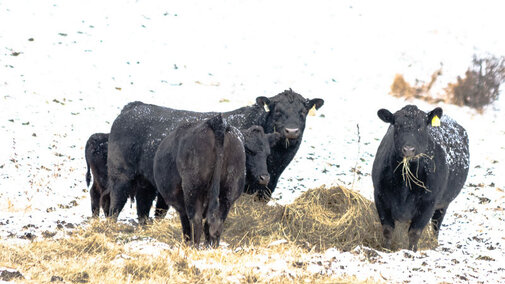Reducing Hay Losses
By Brad Schick
Making, transporting and feeding hay is a large investment in time, equipment and money. How can you reduce loss of hay during feeding to make that investment go further?
There are many ways to feed hay, with each method impacting waste differently. If hay is fed unrestricted, cattle can waste 45% of the hay they are provided. Limit feeding hay so only what is required is fed will significantly reduce waste right away. Studies show that cattle fed daily versus fed every four days needed 25% less hay. That’s a huge amount, but labor and equipment cost slightly increased.
A common and usually labor-efficient method of feeding is to feed hay directly onto the ground by unrolling bales, distributing ground hay or loose hay, and bale pod grazing. With any of these methods, there should only be enough feed distributed or available for one day.
Bale pod grazing might be another consideration. Bales are spread out across a field or pasture and temporary fence is used to confine animal access to one or several bales. When it’s time for more hay, the producer moves a fence instead of moving a bale. The losses will depend on herd size, however, because this relates to limiting feeding or limiting access.
Limiting access by physical barriers is another way to decrease hay loss. Bale rings, racks, fences, feed bunks, bale pod grazing or another form of limited access can all decrease waste. These methods work by reducing trampling and animal ability to lay down on the hay. The most effective physical barriers have solid side bottoms. This prevents the hay being pulled out onto the ground. While these methods are effective, they require the purchase of additional equipment that can add significant time and money for large herds or changing feeding location.
No matter the improved method, reducing fed hay losses will improve the return on the hay investment.
Year in Review
As humans, we often like to try and compare things to average or normal. Was the precipitation received within the expected normal range? Were temperatures for a particular season outside of normal? Was our pasture or hay production in the range we consider normal?
Taking this time to look back on last year is beneficial but resist the temptation to compare things to normal. Very rarely do things in the ever-changing world of agriculture really meet average or normal.
Depending on where you live in Nebraska, 2021 may have been too dry or just right. Even if we stick to one location, depending on the time of year, temperatures may have been too cold or too hot. Nature is never static. If it were, our job as producers would be much easier. As it is, we lay out our plans then inevitably have to adapt as Mother Nature throws one curveball after another our way. Did anyone foresee the late season armyworm menace we dealt with this year?
Producers work in a dynamic system that seldom repeats itself. In doing so, we learn to be adaptive, to build resilience into our production and planning, and try to spread our eggs out amongst several different baskets. When you take time to look back this year on the challenges and successes, try to see where adapting to a problem worked or how a bit more flexibility next year could keep an issue from arising. Leave the normal and average comparisons out.

